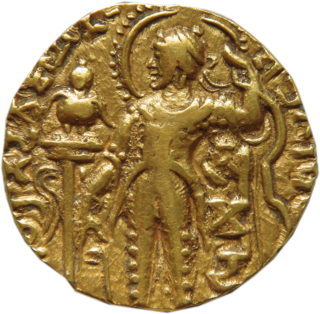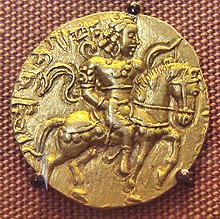The Gupta Empire was an ancient Indian empire on the Indian subcontinent which existed from the early 4th century CE to early 6th century CE. At its zenith, from approximately 319 to 467 CE, it covered much of the Indian subcontinent. This period has been considered as the Golden Age of India by historians, although this characterisation has been disputed by some other historians. The ruling dynasty of the empire was founded by Gupta and the most notable rulers of the dynasty were Chandragupta I, Samudragupta, Chandragupta II, Kumaragupta I and Skandagupta. The 4th-century CE Sanskrit poet Kalidasa credits the Guptas with having conquered about twenty-one kingdoms, both in and outside India, including the kingdoms of Persians, the Hunas, the Kambojas, tribes located in the west and east Oxus valleys, the Kinnaras, Kiratas, and others.

Chandragupta II, also known by his title Vikramaditya, as well as Chandragupta Vikramaditya, was the third ruler of the Gupta Empire in India. Modern scholars generally identify him with King Chandra of the Delhi iron pillar inscription.

Chandragupta I was a king of the Gupta Empire, who ruled in northern and central India. His title Mahārājadhirāja suggests that he was the first emperor of the dynasty. It is not certain how he turned his small ancestral kingdom into an empire, although a widely accepted theory among modern historians is that his marriage to the Licchavi princess Kumaradevi helped him extend his political power. Their son Samudragupta further expanded the Gupta empire.

Samudragupta (Gupta script: Sa-mu-dra-gu-pta, was the second emperor of the Gupta Empire of ancient India, and is regarded among the greatest rulers of India. As a son of the Gupta emperor Chandragupta I and the Licchavi princess Kumaradevi, he greatly expanded his dynasty's political and military power.

Kumaragupta I was an emperor of the Gupta Empire of Ancient India. A son of the Gupta emperor Chandragupta II and Queen Dhruvadevi. He seems to have maintained control of his inherited territory, which extended from Gujarat in the west to Bengal region in the east.

The Indo-Scythians were a group of nomadic people of Iranic Scythian origin who migrated from Central Asia southward into the northwestern Indian subcontinent: the present-day South Asian regions of Afghanistan, Pakistan, Eastern Iran and northern India. The migrations persisted from the middle of the second century BCE to the fourth century CE.

Ramagupta, according to the Sanskrit play Devichandraguptam, was an emperor of the Gupta dynasty of northern India. The surviving fragments of the play, combined with other literary evidence, suggest that he agreed to surrender his wife Dhruvadevi to a Shaka enemy: However, his brother Chandragupta II killed the Shaka enemy, and later dethroned him, marrying Dhruvadevi.

The Shaka era is a historical Hindu calendar era, the epoch of which corresponds to Julian year 78.
The Western Satraps, or Western Kshatrapas were Indo-Scythian (Saka) rulers of the western and central parts of India, between 35 and 415 CE. The Western Satraps were contemporaneous with the Kushans who ruled the northern part of the Indian subcontinent, and were possibly vassals of the Kushans. They were also contemporaneous with the Satavahana (Andhra) who ruled in Central India. They are called "Western Satraps" in modern historiography in order to differentiate them from the "Northern Satraps", who ruled in Punjab and Mathura until the 2nd century CE.

The Vakataka dynasty was an ancient Indian dynasty that originated from the Deccan in the mid-3rd century CE. Their state is believed to have extended from the southern edges of Malwa and Gujarat in the north to the Tungabhadra River in the south as well as from the Arabian Sea in the west to the edges of Chhattisgarh in the east. They were the most important successors of the Satavahanas in the Deccan and contemporaneous with the Guptas in northern India.

Rudrasimha III was the last ruler of the Western Satraps in India, in the 4th century AD. Rudrasimha III succeeded Rudrasena IV as the leader of the Indo-Scythians in India. Both were the sons of the Saka ruler Satyasimha, making them at least half-brothers, if not first-degree relatives.

Rudrasena II (256–278) was a king of the Western Satraps, and the 19th ruler of the Kshatrapa dynasty. The Kshatrapa dynasty seems to have reached a high level of prosperity under his rule.

The Kanakerha inscription, also spelled Kanakherha inscription, is an inscription found on the side of the hill of Sanchi, dating to the 3rd or 4th century CE.

Yasodhaman II (317–332) was a son and probably sub-king of king Rudrasimha II of the Western Satraps. He declared on his coins to be the son of Rudrasimha II.

Viśvasena was a ruler of the Western Satraps, and the 22nd ruler of the Kshatrapa dynasty. He was the last Kshatrapa ruler of the Chastana family, brother and successor to Bhartrdaman and son of Rudrasena II.

Sridharavarman was a Saka (Indo-Scythian) ruler of Central India, around the areas of Vidisa, Sanchi and Eran in the 4th century CE, just before the Gupta Empire expansion in these areas. He calls himself a general and "righteous conqueror" in an inscription, and Rajan ('King') and Mahaksatrapa in a probably later inscription at Eran, suggesting that he may have been a high-ranked officer who later rose to the rank of a King.

Gupta art is the art of the Gupta Empire, which ruled most of northern India, with its peak between about 300 and 480 CE, surviving in much reduced form until c. 550. The Gupta period is generally regarded as a classic peak and golden age of North Indian art for all the major religious groups. Gupta art is characterized by its "Classical decorum", in contrast to the subsequent Indian medieval art, which "subordinated the figure to the larger religious purpose".

The Abhira dynasty was a dynasty that ruled over the western Deccan, where it perhaps succeeded the Satavahana dynasty. From 203 CE to roughly 270 or 370, this dynasty formed a vast kingdom. The Abhiras had an extensive empire comprising Maharashtra, Konkan, Gujarat and part of south Madhya Pradesh.
The emergence of the Great Kushans in Bactria and Northwestern India during the first century CE reshaped the geopolitical landscape of the region, impacting trade routes, international politics, and regional power dynamics. Economically, the Kushans served as intermediaries in trade, controlling crucial sections of the Silk Road and redirecting trade between China, India, and the eastern countries away from Parthian territory. This posed a significant economic challenge to the Parthians and positioned the Kushans as major players in international trade. Politically, the rise of the Kushans had profound implications for Iran, as it found itself sandwiched between the Roman Empire and the Kushans. The Romans recognized the strategic importance of the Kushan Empire and sought direct relations with its rulers to safeguard trade routes between Rome, China, and India. This geopolitical scenario led the early Sasanians to prioritize the conquest of the Kushan empire in their Eastern policy, eventually achieving remarkable success under Emperor Ardashir I. Following the decline of the Great Kushans, remnants known as the "Little Kushans" persisted in the Punjab region, eventually being subjugated by the Gupta Empire under Samudragupta. His inscription on the Allahabad pillar illustrates Gupta dominance over the last Kushan rulers, who were forced to accept Gupta suzerainty. Samudragupta's strategic alliances and military campaigns against the Sassanians and other regional powers solidified Gupta control over large parts of the Indian subcontinent. However, the Gupta Empire faced various challenges, including incursions by the Hunas, who posed a considerable threat to neighboring civilizations. Skandagupta's leadership and military strategy were crucial in resisting Huna advances, although the extent of damage caused by their invasions remains debated among scholars. Despite facing external pressures, internal succession issues within the Gupta dynasty, such as the question of rightful heirs, also contributed to the complexities of governance during that time.




























